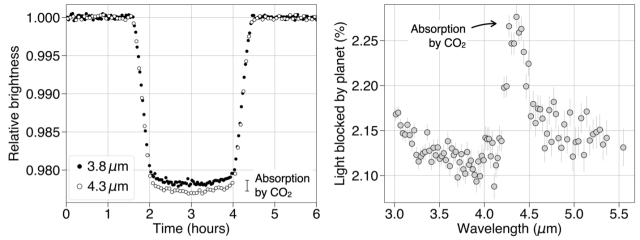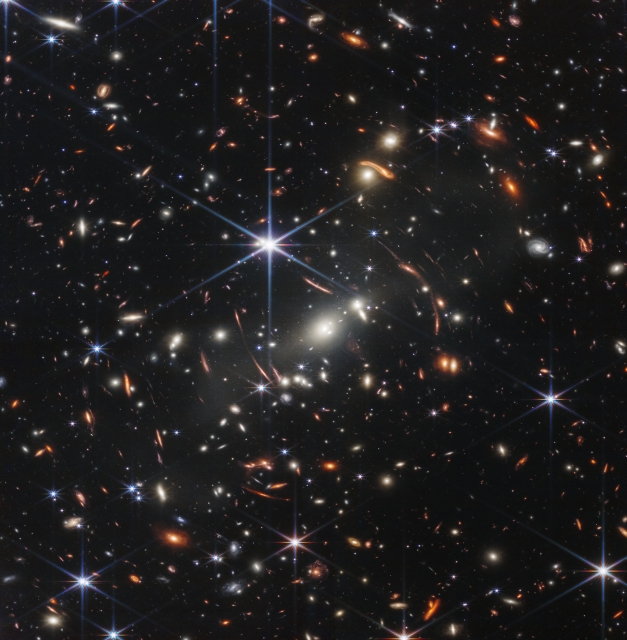On July 11, 2022, U.S. President Biden revealed the First Official Image obtained with the James Webb Space Telescope. “And today,” said Biden, introducing this public event, “we’re going to get a glimpse of … light from other worlds, orbiting stars far beyond our own.” He was talking about the Webb telescope’s potential to study exoplanets, which is one of the hottest topics in astrophysics and has been the focus of my research for nearly 20 years.
Then, the image was unveiled: a panorama of thousands of distant galaxies, billions of light years away, each containing countless stars. Breathtaking! I knew it would delight my colleagues in cosmology, the study of the entire universe rather than any particular galaxy, star, or planet. I made a note to order a large print for my office.
It was a terrific way to start the press event—but where were the exoplanets? I waited for Bill Nelson, the head of NASA, to dazzle President Biden with exoplanetary data.
My anticipation grew as Nelson raved about the telescope: “It is going to be so precise, you’re going to see whether or not planets, because of the chemical composition that we can determine with this telescope of their atmosphere, if those planets are habitable.” To which the President responded, “It’s amazing. I wonder what the press is like in those other places.” Then, the President left.
How disappointing! NASA missed an opportunity to show off one of the Webb telescope’s greatest superpowers—the ability to probe the atmospheres of planets that are light years away and possibly even detect molecules indicative of life.
I do understand why Nelson stuck with the galaxy image, even as he spoke about exoplanets. It’s easy to appreciate images of beautiful galaxies and admire the variety of colors and shapes as you ponder their vast sizes and remote distances. But we cannot make images of exoplanets. Even with our most powerful telescopes, a distant star appears as a structureless point of light. The much fainter light from any orbiting planets is usually lost in the glare from the star.
Nevertheless, we can learn a lot about exoplanets. For example, one of the Webb Telescope’s earliest targets was the planet Bocaprins, which orbits a Sun-like star located 700 light years away in the direction of the Virgo constellation. Even though Bocaprins is impossible to see in any image, we know its diameter is about 91,000 kilometers, its “year” (the time needed to complete a full orbit around the star) is 4.06 Earth days, and its atmosphere contains carbon dioxide, water vapor, and sulfur dioxide.
What manner of sorcery is this? How can the Webb telescope or any telescope reveal such intimate details about an unseen planet? Here’s what I would have told President Biden:
The trick is to observe eclipses. From our vantage point in the galaxy, Bocaprins’ orbit happens to carry it directly in front of its home star, blocking a small portion of the star’s light. During an eclipse, the star appears to fade in brightness by about 2%, from which we can conclude that the planet covers about 2% of the star’s visible surface. From that fact, we can calculate the planet’s diameter. These miniature eclipses recur every 4.06 days, thereby revealing the length of the planet’s “year.”

To probe the planet’s atmosphere, we play another trick: we observe eclipses with a spectrograph, a device that spreads the starlight into a rainbow of colors. During an eclipse, some of the colors in the rainbow appear slightly darker than usual. This is because a small portion of the starlight filters through the planet’s atmosphere, and each molecule in the atmosphere has a unique set of “favorite colors” that it absorbs more than others. By observing which colors are missing from the rainbow, we can identify the molecules responsible.
The colors of a rainbow are quantified by the wavelength of light, from 0.4 µm (millionths of a meter) for violet to 0.7 µm for red. The Webb telescope specializes in red and infrared (“redder than red”) wavelengths, from 0.6 to 29 µm. Webb has performed spectroscopy during eclipses of Bocaprins, and the results can be visualized in a chart showing the percentage change in the star’s brightness at dozens of wavelengths. The planet blocks slightly more light at 4.3 µm than at surrounding wavelengths, implicating carbon dioxide. Similar features elsewhere in the spectrum betray the presence of sulfur dioxide and water vapor.
After this explanation of spectroscopy, I would have invited the President to reflect on the fact that by analyzing the light of a distant star, we can not only reveal the existence of a giant planet, but also discern that the planet’s atmosphere is a little steamy.
What about the connection to the search for life on other planets? The idea is that biological processes might produce detectable changes in a planet’s atmosphere. Life on Earth proves the point. Oxygen is abundant in our atmosphere only because photosynthetic organisms—plants, algae, and cyanobacteria—are constantly replenishing it. Without photosynthesis, most of the oxygen would disappear. That’s why the detection of oxygen in the atmosphere of a planet with similar characteristics to the Earth would be so exciting.
Admittedly, this is a speculative endeavor. Even the Webb telescope is probably not powerful enough to search for oxygen in the atmosphere of a planet as small as the Earth. In this sense, when the NASA chief briefed the President about Webb’s capabilities, he was exaggerating. But the prospect of searching for “biosignature gases” such as oxygen is so alluring that scientists and engineers have already begun designing future telescopes even better than Webb.
Exoplanet scientists have an interesting relationship with the public. Everyone wants to know if life exists elsewhere in the universe. It’s easy to understand why discovering and studying exoplanets is relevant to the long-term quest for life. But the public, conditioned by science fiction, wants to see those planets. Do they have continents and oceans? Moons? Rings, like Saturn? And all we can give them, at present, are structureless points of light and charts of brightness versus time or wavelength.
It’s an obstacle to the immediate public appreciation of our work. But it’s also an opportunity to teach some physics and astronomy—and to convey the marvelous and awe-inspiring fact that we can learn so much from only the flickering brightness and color of a point of light in the sky.
Joshua Winn is professor of astrophysical sciences at Princeton University and a coinvestigator in NASA’s ongoing Transiting Exoplanet Survey Satellite mission.

